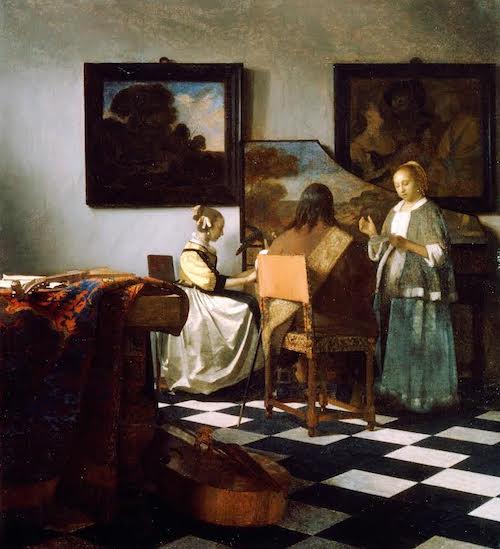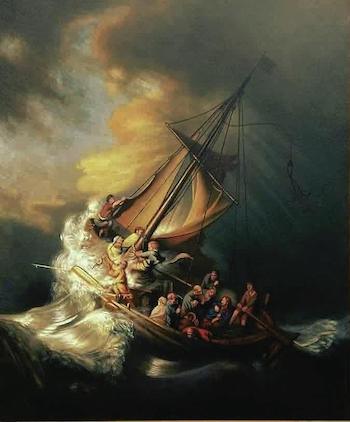Documentary Review: “This Is a Robbery: The World’s Biggest Art Heist” — Real Crime as a Real Damn Shame
By Mark Favermann
This Is a Robbery is the most complete and compelling narrative yet about the looting of the Isabella Stewart Gardner Museum.
This Is a Robbery: The World’s Biggest Art Heist, streaming on Netflix.

Johannes Vermeer, The Concert (1664). Photo: Isabella Stewart Gardner Museum.
It was a perfect storm of institutional arrogance, general ignorance, police and FBI bungling, poorly chosen security staff, and criminal audacity. After three decades, the Isabella Stewart Gardner Museum heist is now the subject of a four-part Netflix documentary by brothers Nick and Colin Barnicle, the Lincoln-bred sons of the sometimes controversial journalist Mike Barnicle. To its credit, This Is a Robbery: The World’s Biggest Art Heist succeeds where other efforts have failed: the dots seem to connect in this detailed look at the winding, disjointed, and stuttering attempts to make sense of the art crime of the century.
The nerviest art theft in history celebrates its birthday each year with Boston’s annual Saint Patrick’s Day observance. And this is a mystery that has been festering for 31 years. The fruitless wrestling — emotional, intellectual, investigative — over the whereabouts of the art stolen by unknown crooks continues unabated.
Amazingly, not much has been discovered of value about the looting: we seem to know little more than we knew just over three plus decades ago. Of course, there’s been lots of journalistic research, theorizing in print and online, and detective work aplenty on local, national, and international levels. An offer of $10 million by the museum and its insurance companies sits unclaimed. After all this, there has been no sign of any of the art being recovered. At least until now.
A mini-media industry has grown around the snatch. Local and national newspapers, magazines, and radio have served up provocative tabloid journalism. There are contemporary blogs, personal theories expounded, and even some novels that speculate about what happened. The growing cast of characters are a colorful bunch: there’s talk about vague leads, potential (mostly deceased or imprisoned) thieves, insinuations regarding low-level hoodlums, ex-cons, notorious art dealers, and even IRA terrorists with connections to similar crimes. Recovery dead ends and hypothetical solutions pop up with depressing regularity.
The truth is, there was wholesale bungling at the start of the case. Initially, the FBI insisted on investigating alone. It makes little sense, but there was no formal assistance requested by the FBI from the Boston Police Department or the Massachusetts State Police. The Fed agent in charge of the initial investigation was just 26 years old. This lazy setup indicates that the G-men were not all that hot-to-trot about the case. Also tragically wet behind the ears — Gardner Museum director Ann Hawley, who at the time had had no serious museum experience. She did not even know what she didn’t know. It is obvious that, in her first 6 months in the job, Hawley had no idea about museum security. She is now a very attractive and retired director, a reassuring doyenne who eloquently says nothing of evidentiary value in the documentary.
Whitey Bulger’s infamous name is inevitably thrown into the mix of probable villains. But there is no indication that he cared for art or had the patience and knowledge to fence masterpieces. This kind of caper was not in his seedy wheelhouse. But who knows? Perhaps, the art sits (hopefully securely) in a barn in the west of Ireland. If so, let’s pray the barn is climate controlled and has sensitive low light.

Rembrandt’s Storm on the Sea of Galilee (1633). Photo: Isabella Stewart Gardner Museum.
Myles Connor, a notoriously affable local art thief and rock musician in the Boston area, is always referenced. The son of a cop and the brother of a priest, he attended art galleries and museum exhibition openings. He actually seemed to like and know something about high art. Connor was serving 15 years in a Rhode Island prison for stolen antiques when the Gardner Heist occurred. He surfaced early on as a possible mastermind of the theft. He has given several interviews over the years to the Feds with no real results.
Connor claimed in a 1997 Time interview that, if he had planned the job, he would have lifted Titian’s 1562 Rape of Europa. This magnificent picture is considered by many art historians to be the greatest painting in any New England museum collection. The Gardner robbers left the Titian on the third floor, untouched. Connor also claimed that, back in the ’70s, he visited the Gardner and discussed how easy it would be to steal art from the museum with a criminal associate, Bobby Donati. Supposedly, Donati showed great interest in a Napoleonic flag finial, which was the least valuable Gardner piece that was stolen.
Soon after Connor’s Donati meeting, a Rembrandt was stolen off the wall from the Boston Museum of Fine Arts. He never admitted the theft, but Connor arranged its return to avoid prison time for another art theft in Maine. Connor claimed that Donati and his crony, David Houghton, arranged the Gardner heist on their own, though it was based on Connor’s earlier plan. Instead of using art thieves, he says, they used less sensitive armored car robbers dressed in Boston Police uniforms. In 1991 Donati was found dead — hogtied and stabbed — in the trunk of a car. Houghton died in 1992. Connor suggested that the two told him where the loot could be found, but he would have to be let out of prison to secure it. The Feds did not play along, but they did raise the reward from $1 million to $5 million. After two decades, the reward went up to $10 million.
What happened to the works of art is also a conundrum. Of course, besides notions starring Hollywood-inspired drug-cartel lords and megarich arms dealers, there is speculation about rogue Arab oil sheiks sitting in their elegant and opulent desert palaces, smiles on their faces as they look at Rembrandt and Vermeer paintings in secret rooms. In the early ’90s the art-loving bad guys were thought to be sinister Japanese Yakuza chiefs. But then the Japanese yen fell and the country went into stagflation. The practical Japanese would no doubt have traded the invaluable pieces for gold or pearls. The horrifying nightmare that sits behind the fantasies: the notion that the artwork was destroyed by flood or fire in an old warehouse.
This Is a Robbery: The World’s Biggest Art Heist proves that we are in an investigatory quagmire. All we have to show are whiffs of clues, missed tips, and a tawdry circus of underworld characters. The empty frames remain on the museum’s walls, supposedly because there is a codicil in the will that nothing be changed in the museum after the death of Mrs. Jack (Isabella Stewart) Gardner — or the ownership of the palazzo and all its contents will revert to Harvard University. Of course, if that is true there is a glaring contradiction: didn’t the thieves change things in 1990?

Have you seen this man? Manet’s Chez Tortoni (1875). Photo: Isabella Stewart Gardner Museum.
Frankly, the quiet is disconcerting, especially in a blabbermouth town like Boston. It is an odd, very peculiar case. For the first time, this excellent, thought-provoking four-part documentary shows just how strange this case is, painstakingly connecting the various criminals and thieves in contention. None of the previous articles and films on the heist were as thorough as this series in digging into the links among the plethora of potential robbers and fences.
This Is a Robbery actually identifies individuals of interest. The lineup includes Connor and Donati; Donati’s association with Boston organized crime figure Bobby Guarente; Guarente’s links to Dorchester crime boss Carmello Merlino, who is thought to have orchestrated the heist; and Guarente’s friendship with thief and conman Bobby Gentile, whose Connecticut house was searched — its yard dug up — a few years ago. Almost all of these suspicious culprits are now ill or dead from natural and unnatural causes. Now we have the most complete and compelling narrative yet about the Gardner looting — real crime as a real damn shame. An elemental and traumatic question remains: where are the 13 artworks?
An urban designer and public artist, Mark Favermann has been deeply involved in branding, enhancing, and making more accessible parts of cities, sports venues, and key institutions. Also an award-winning public artist, he creates functional public art as civic design. The designer of the renovated Coolidge Corner Theatre, he is design consultant to the Massachusetts Downtown Initiative Program and, since 2002, he has been a design consultant to the Red Sox. Writing about urbanism, architecture, design and fine arts, Mark is Associate Editor of Arts Fuse.
Tagged: Colin Barnicle, Isabella-Stewart-Gardner-Museum, Netflix, Nick Barnicle

Well-written and provocative article Mark. I hope you read my novel A Discerning Eye that takes off from the Gardner theft. No one except for my protagonist Portia Malatesta ever analyzed the stolen paintings and came up with an underlying theme.
Is Ann Hawley’s present-day appearance relevant?
She was the director when the theft occurred.
Nice article. This Netflix documentary is a nice companion to Boston Globe’s podcast “Last Scene,” which follows some of the same leads–some maybe even more in-depth.